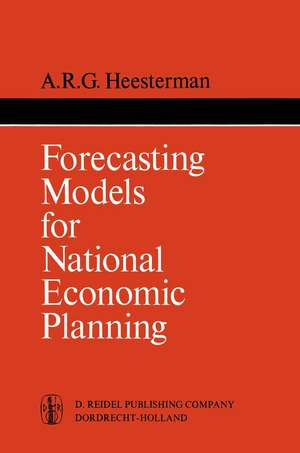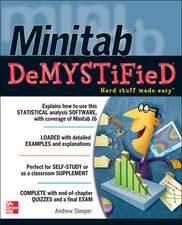Forecasting Models for National Economic Planning: International Studies in Economics and Econometrics, cartea 2
Autor Aaart R. Heestermanen Limba Engleză Paperback – 6 noi 2011
Din seria International Studies in Economics and Econometrics
- 15%
 Preț: 586.02 lei
Preț: 586.02 lei -
 Preț: 358.56 lei
Preț: 358.56 lei -
 Preț: 391.40 lei
Preț: 391.40 lei -
 Preț: 390.25 lei
Preț: 390.25 lei - 5%
 Preț: 656.62 lei
Preț: 656.62 lei -
 Preț: 394.12 lei
Preț: 394.12 lei - 15%
 Preț: 643.99 lei
Preț: 643.99 lei -
 Preț: 390.46 lei
Preț: 390.46 lei -
 Preț: 387.75 lei
Preț: 387.75 lei -
 Preț: 390.08 lei
Preț: 390.08 lei -
 Preț: 397.01 lei
Preț: 397.01 lei -
 Preț: 389.11 lei
Preț: 389.11 lei - 18%
 Preț: 801.83 lei
Preț: 801.83 lei -
 Preț: 389.49 lei
Preț: 389.49 lei -
 Preț: 382.75 lei
Preț: 382.75 lei -
 Preț: 383.33 lei
Preț: 383.33 lei -
 Preț: 387.75 lei
Preț: 387.75 lei -
 Preț: 383.71 lei
Preț: 383.71 lei -
 Preț: 384.86 lei
Preț: 384.86 lei - 15%
 Preț: 642.83 lei
Preț: 642.83 lei - 15%
 Preț: 639.90 lei
Preț: 639.90 lei -
 Preț: 383.12 lei
Preț: 383.12 lei -
 Preț: 386.00 lei
Preț: 386.00 lei - 18%
 Preț: 955.70 lei
Preț: 955.70 lei - 15%
 Preț: 639.73 lei
Preț: 639.73 lei - 15%
 Preț: 643.48 lei
Preț: 643.48 lei - 15%
 Preț: 636.30 lei
Preț: 636.30 lei - 18%
 Preț: 954.62 lei
Preț: 954.62 lei - 18%
 Preț: 952.72 lei
Preț: 952.72 lei -
 Preț: 384.86 lei
Preț: 384.86 lei - 15%
 Preț: 645.60 lei
Preț: 645.60 lei - 15%
 Preț: 645.28 lei
Preț: 645.28 lei - 18%
 Preț: 953.35 lei
Preț: 953.35 lei - 18%
 Preț: 945.30 lei
Preț: 945.30 lei -
 Preț: 380.25 lei
Preț: 380.25 lei -
 Preț: 379.30 lei
Preț: 379.30 lei -
 Preț: 394.87 lei
Preț: 394.87 lei - 15%
 Preț: 589.95 lei
Preț: 589.95 lei -
 Preț: 383.33 lei
Preț: 383.33 lei - 15%
 Preț: 641.85 lei
Preț: 641.85 lei
Preț: 380.45 lei
Nou
Puncte Express: 571
Preț estimativ în valută:
72.82€ • 79.13$ • 61.21£
72.82€ • 79.13$ • 61.21£
Carte tipărită la comandă
Livrare economică 21 aprilie-05 mai
Preluare comenzi: 021 569.72.76
Specificații
ISBN-13: 9789401031417
ISBN-10: 940103141X
Pagini: 172
Ilustrații: 166 p.
Dimensiuni: 152 x 229 x 9 mm
Greutate: 0.24 kg
Ediția:2nd ed. 1972
Editura: SPRINGER NETHERLANDS
Colecția Springer
Seria International Studies in Economics and Econometrics
Locul publicării:Dordrecht, Netherlands
ISBN-10: 940103141X
Pagini: 172
Ilustrații: 166 p.
Dimensiuni: 152 x 229 x 9 mm
Greutate: 0.24 kg
Ediția:2nd ed. 1972
Editura: SPRINGER NETHERLANDS
Colecția Springer
Seria International Studies in Economics and Econometrics
Locul publicării:Dordrecht, Netherlands
Public țintă
ResearchCuprins
Preface and Introduction.- Preface to the Second Edition.- I. The Basic Concepts of Linear Models.- 1.1. Economic Equation Systems.- 1.2. Some Conventions of Notation.- 1.3. The Basic Block-Equation.- 1.4. Some Types of Relations.- 1.5. The Nature of Stochastic Relations.- 1.6. Instruments, Target-Variables and Data.- 1.7. The Conditional Forecast.- 1.8. The Reduced Form.- 1.9. Subsystems.- II. The Short-term Forecasting Model.- 2.1. What is’ short-Term’?.- 2.2. An Example of a Short-Term Model.- 2.3. Linear Approximation.- 2.4. Production, Income and its Distribution.- 2.5. The Institutional Relations.- 2.6. The Demand for Production Factors.- 2.7. The Consumption Function.- 2.8. The Demand for Investment Goods.- 2.9. The Demand for Inventories.- 2.10. The Price Equations.- 2.11. Supply and Demand.- 2.12. Capacity.- 2.13. Built-in Stabilizers.- 2.14. The Use of Percentage Increments.- 2.15. Summary of the Short-Term Forecasting Model.- III. The (Static) Input-Output Model.- 3.1. Use of the Input-Output Model.- 3.2. The Input-Output Table.- 3.3. The Input-Output Production Model.- 3.4. The Matrix Formulae.- 3.5. Cumulative Input-Output Coefficients.- 3.6. Allocation under Capacity Limits.- 3.7. Artificial Sectors.- 3.8. The Input-Output Costing Model.- 3.9. Units of Measurement.- 3.10. The Requirements of Productiveness.- 3.11. The Generalized Input-Output Model.- 3.12. Regional Input-Output Models.- 3.13. History of Input-Output Analysis.- IV. Some Building Stones of Sectorized Models.- 4.1. The Extended Input-Output Model.- 4.2. Average and Marginal Input Coefficients.- 4.3. Stone’s Linear Expenditure System.- 4.4. Price-Based Substitution in Input-Output Models.- 4.5. An Input-Output System with Substitution and Technical Progress.- 4.6. Unequal Lags.- V.Capital-Output Ratios.- 5.1. The Harrod-Domar Model.- 5.2. Those Awful Data.- 5.3. The Role of Technical Innovation.- 5.4. The Computation of Capital-Output Ratios.- 5.5. In Defence of the Gross Ratio.- VI. The Dynamics of Economic Growth.- 6.1. The Dynamic Input-Output Model.- 6.2. The Accelerator Model.- 6.3. The Quasi-Static Model.- 6.4. The National Plan.- VII. Dynamic Adjustment Models and their Convergence.- 7.1. The Dichotomy.- 7.2. The Causal Chain.- 7.3. The Cumulative Forecast.- 7.4. The Long-Run Equilibrium.- 7.5. The Problem of Stability.- 7.6. The’ simple’ Long-Term Model.- VIII. Forecast and Policy.- 8.1. Data and Instruments.- 8.2. The Policy Programming Problem.- 8.3. Tinbergen’s Method of Instruments and Targets.- 8.4. Theil’s Quadratic Programming Approach.- List of some of the Tables and the Examples to which they belong.








